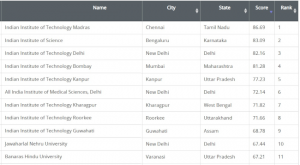
India has been on a privatisation drive in its public education space, driven by the belief that private institutions are more efficient at delivering quality education. However, the latest National Institutional Ranking Framework (NIRF) rankings reveal that most of the finest educational institutions in India are government-funded, highlighting the need to increase public expenditure to develop and strengthen such institutions.
In 2018, the Narendra Modi government granted autonomous status to 52 universities and eight colleges. This move was criticised for being elitist and disregarding the freedom of millions of students aspiring for higher education. In a country where only a quarter of college-aged individuals are able to attend due to socio-economic factors, granting autonomous status was seen as a means to allow universities and colleges to raise fees, thus transforming higher education into a profit-driven business and making it unaffordable for a large part of the population.
READ | Odisha crash: Indian Railways draws flak for misplaced priorities
Education should be recognised and treated as a fundamental right of citizens and an essential instrument for national development. The responsibility lies with the government to view education as a public good rather than a commodity and provide it to students equitably. Education remains a pathway to upward social and economic mobility, particularly for those who lack generational wealth or other social privileges. For a poor country like India, offering unrestricted access to quality education is essential to unlock the untapped potential of its burgeoning youth population.
Public universities shine in NIRF Rankings
Nevertheless, the latest NIRF rankings underscore the significance of public universities and their contribution to India’s educational system. the Indian Institute of Technology (IIT)-Madras has retained its position as the top institute in the country in the India Rankings 2023 report — for the fifth consecutive year. In fact, public universities dominate the rankings, with IIT-Madras leading the overall category, followed by the Indian Institute of Sciences (IISc), Bengaluru, and IIT-Delhi.
Overall top 10 best universities 2023

In various categories, public institutions have secured the top spots. Miranda House, affiliated with Delhi University, ranked first among colleges, while Hindu College (also affiliated with Delhi University) and Presidency College in Chennai claimed the second and third positions, respectively. The All India Institute of Medical Sciences (AIIMS) Delhi topped the medical institutes category, with the Post Graduate Institute of Medical Education and Research (PGIMER), Chandigarh, following closely behind. In the law colleges category, the National Law School of India University, Bangalore, and the National Law University, Delhi, took the top two spots, with Nalsar University of Law, Hyderabad, securing the third position. All of these institutions are public universities and colleges.
Public universities continued their success in the university category as well with IISc Bengaluru leading the rankings, followed by Jawaharlal Nehru University (JNU), Delhi in second place and Jamia Millia Islamia, Delhi in third place.
The National Education Policy (NEP) 2020, the country’s guiding policy document in the field of education, emphasises that achieving equitable and high-quality education for all requires increased public investment in the education sector. The policy also mandates allocating a minimum of 6% of the country’s Gross Domestic Product (GDP) towards strengthening education. However, according to the latest Economic Survey, the actual allocation falls significantly short of this requirement, standing at a dismal 2.9%.
The NIRF report, published by the ministry of education ranks higher education institutes across various categories, including overall, university, college, engineering, management, medical, research, law, pharmacy, research, and architecture. This year, two new categories, innovation and agriculture, and allied sectors, have also been introduced in the rankings.

